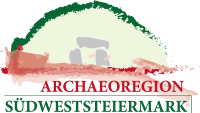The EU project “Interactive archaeological heritage of Austrian and Slovenian Styria / Interaktivna arheološka dediščina avstrijske in slovenske Štajerske” (InterArch-Styria), funded by the Slovenia-Austria cross-border cooperation program 2007-2013, stands for free and open access to the common archaeological heritage of Slovenia and Austria.
The project InterArch-Styria was prepared in 2010 in cooperation of Joanneum Universal Museum with partners from Austria and Slovenia and submitted to the second open call within the operational program Slovenia-Austria 2007-2013. The Slovenia-Austria cross-border cooperation program is one of the European Territorial Cooperation (ETC) programs financed by the European Regional Development Fund (ERDF). The total budget for the project was almost 820,000 euros. The project ran for three years.
The project faced a huge task in August 2011: nearly 9,000 archaeological objects found before 1918 in the northern part of today’s Republic of Slovenia and more than 20,000 pages of related archival documents were waiting to be made accessible to the general public by a team of experts from Slovenia and Austria.
The majority of these objects, together with the written documents, is in the archaeological collections of the Joanneum Universal Museum, founded in 1811, because northern Slovenia – the so-called Štajerska – belonged to the Duchy of Styria until the end of the Habsburg monarchy. In addition, written sources relevant to the archaeological research of northern Slovenia dating from the 19th century are kept in other Austrian and Slovenian archives and museums, especially in the Kunsthistorisches Museum in Vienna and – together with about 1,000 finds – in the Pomurski muzej in Murska Sobota.
All these archaeological objects and written documents are of outstanding importance as sources for the research of the history of Slovenia and for the preservation of Slovenian monuments.
In order to make these materials accessible to people on both sides of the border, the project team, consisting of representatives from the six Slovenian and Austrian partner institutions, first developed a common digital tool. Then an innovative bilingual database was built, in which the archaeological objects and archival materials were included. The results can be accessed on the website www.interarch-steiermark.eu.
The database, which was made available for free use at the end of the project, is not only suitable for archival records and objects, but also for recording current archaeological excavations and their web presentations. For this purpose, the municipal members of the Kulturpark Hengist were included as a trial region. Archaeological field surveys and 3D objects from the region thus bring an ancient cultural landscape to light.
“Brought to Light” was also the title of a traveling exhibition that rounded off the project’s public relations work, along with a conference and a study exhibition. This exhibition, which traveled from Maribor to Ljubljana, Celje, Ormož and Murska Sobota in 2012, featured archaeological objects brought to the Joanneum in Graz from Slovenian sites during the Nazi era of 1941-45. The objects, which had never been shown before, were returned to the Republic of Slovenia by the Province of Styria during the opening of the exhibition in Murska Sobota.
Project partners:
- Joanneum Universal Museum / Univerzalni muzej Joanneum (Lead partner)
- Evropski kulturni in tehnološki center Maribor / European cultural and technological center Maribor
- Karl Franzens University Graz, Institute for Archaeology / Karl-Franzens univerza Gradec, Inštitut za arheologijo
- Zavod za varstvo kulturne dediščine Slovenije / Monuments Office of Slovenia
- Kulturpark Hengist / Društvo kulturni park Hengist
- Pomurski muzej Murska Sobota / Pomurje Museum Murska Sobota
Department of Archaeology and Coin Cabinet
Eggenberger Allee 90
A-8020 Graz
T: + 43 316 8017 9560
archaeologie@museum-joanneum.at
www.museum-joanneum.at
Text: Dr. Marko Mele


